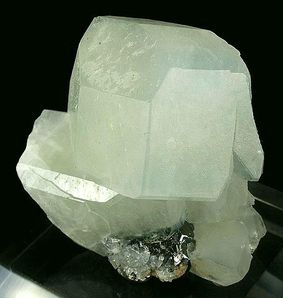|
| Name Origin |
From a Greek word meaning to divide because of the granular nature of the massive variety |
|---|---|
| Chemical Formula | CaBSiO4(OH) |
| Color | colorless, white, pale yellow, green, also pink, reddish, and brownish due to impurities; massive varieties can be white to orange-brown or pink |
| Hardness | 5-5.5 on Mohs Scale |
| Crystal System | Monoclinic. Crystals prismatic or stubby; massive, granular |
| Pleochroism | None |
| Cleavage |
None |
| Specific Gravity (SG) |
2.8-3 |
| Luster |
Vitreous |
| Fracture | Subconchoidal to uneven, brittle |
Note: Datolite is rather soft gemstone if wear is considered. The nodules come in very attractive colors. Faceted stones are extremely brilliant, though their dispersion is low. Most faceted gems are colorless, pale yellowish or pale green. Datolite is first discovered by Jens Esmark in 1806.
Photo credit:
"Datolite-rom25c" by Rob Lavinsky, iRocks.com – CC-BY-SA-3.0. Licensed under CC BY-SA 3.0 via Wikimedia Commons.


